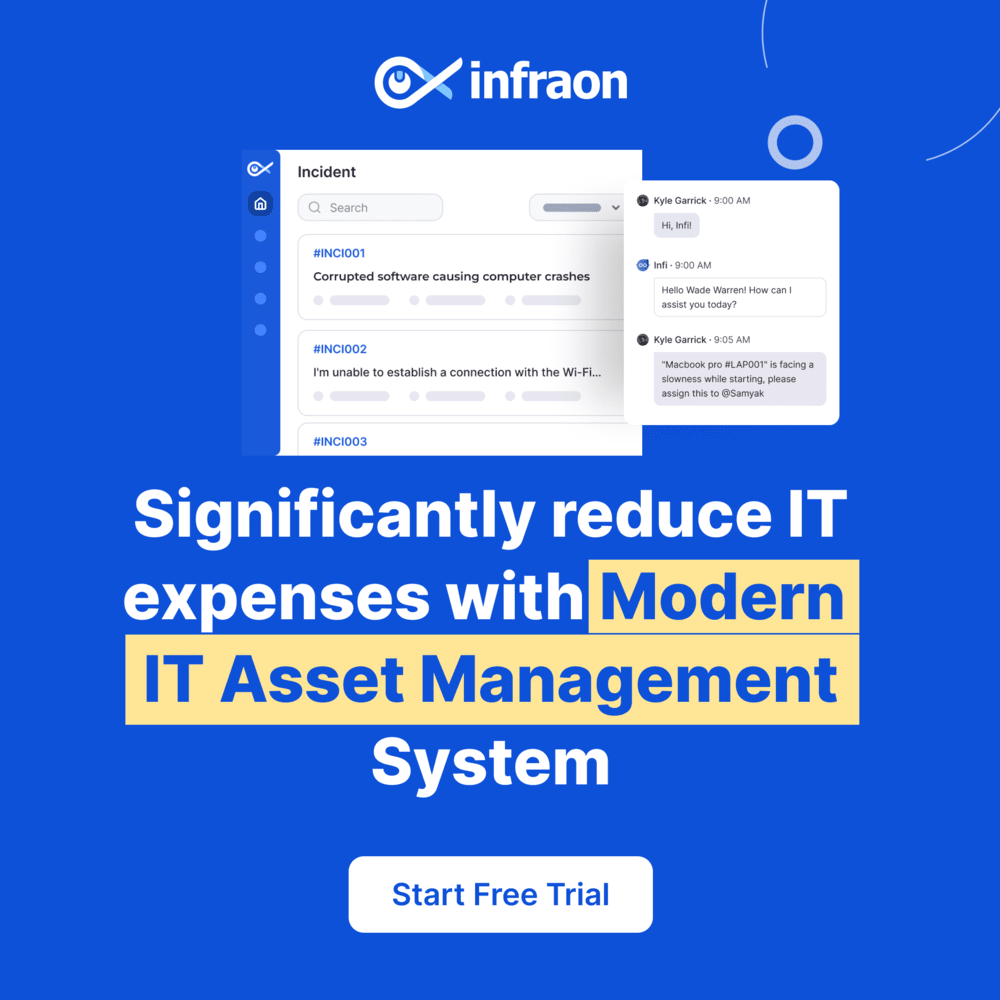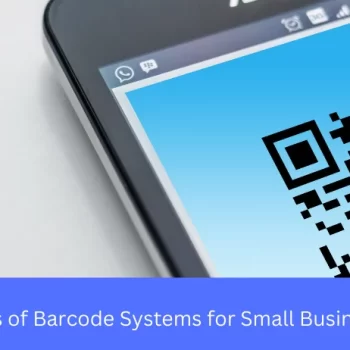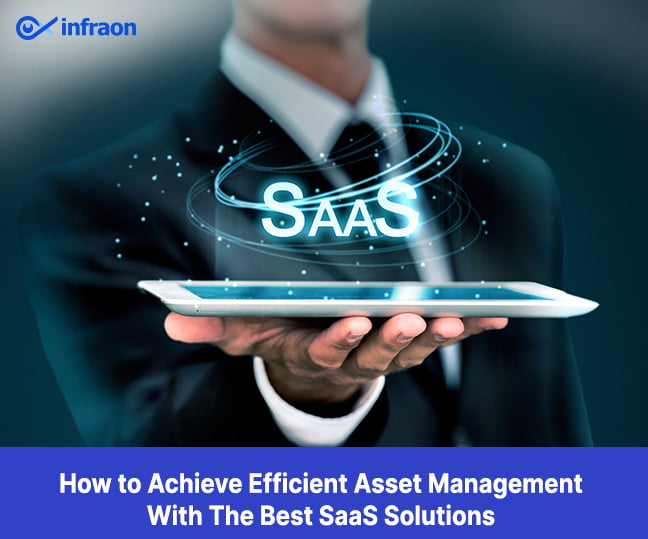In the fast-paced realm of modern business, efficiently tracking and managing a diverse array of assets, from hardware and software to virtual and non-IT resources, is imperative. Implementing robust IT asset management best practices is the key to achieving this seamlessly.
By adopting an ITAM strategy, organizations can unlock a multitude of benefits, including the reduction of high maintenance costs, optimal utilization of software licenses, mitigation of underutilized assets, fortification against security threats, readiness for audits, augmentation of ITIL processes, informed procurement decisions, precise budgeting, and much more.
Businesses often rely on an extensive network of vendors and providers to source the necessary hardware, software, and critical components for maintaining and advancing their IT infrastructure. This comprehensive guide delves into the best practices of IT Asset Management (ITAM), offering insights that streamline operations, unveil significant cost savings, and enhance overall performance within this ever-evolving ecosystem.
Related article: The Ultimate Guide to IT Asset Management: A Step-by-Step Checklist
What is IT Asset Management (ITAM)?
IT Asset Management (ITAM) is a complete and strategic approach to precisely manage an organization’s information technology assets throughout its entire lifecycle. This strategy encompasses acquiring, tracking, maintaining, and retiring IT assets, aiming to maximize their value while minimizing associated risks and costs. ITAM is a critical cornerstone in ensuring that IT resources are procured efficiently, utilized throughout their lifecycle, and are eventually retired or replaced cost-effectively.
Within the framework of ITAM, various key processes come into play, including inventory management, procurement, deployment, maintenance, compliance management, risk mitigation, and vendor interactions. These processes collectively form a robust strategy that empowers organizations to enhance operations, reduce costs, maintain strict compliance with licensing agreements and regulatory requirements, and ultimately unlock the full potential of their IT investments.
Objectives of ITAM:
The objectives of the IT Asset Management (ITAM) process are multifaceted, encompassing crucial aspects of asset optimization, security, and strategic planning:
1. Quantify Unused Asset Value
A fundamental goal of ITAM is to accurately quantify the total value of underutilized or unused hardware and software applications within the organization. This process aids in optimizing asset usage and serves as a cost-cutting measure by identifying surplus assets. By understanding the extent of unused resources, organizations can make informed decisions regarding maintenance costs, allowing for better allocation of resources.
2. Identify Lost Assets
According to Gartner, approximately five percent of assets are subject to theft annually. Detecting and addressing stolen hardware and software applications is a critical ITAM objective. Swift identification and replacement of stolen components are essential to
minimize losses resulting from theft. This proactive approach safeguards assets and prevents potential security breaches associated with stolen hardware or software.
3. Strategic Planning
ITAM extends its reach into strategic planning by assisting organizations in preparing for the future. It enables the assessment of the adverse impact of aging hardware on IT operations, thus helping organizations make informed decisions regarding asset management. Organizations can strategize asset disposal, repair, or replacement by identifying aging equipment. This foresight aids in preventing unexpected losses and ensures that the IT infrastructure remains up-to-date.
The objectives of the ITAM process include financial optimization, security enhancement, and strategic foresight. By achieving these objectives, organizations can maximize the value of their assets and enhance their overall IT operations and long-term sustainability.
Benefits of ITAM processes to your IT:
Implementing IT Asset Management (ITAM) processes substantially benefits an organization’s IT landscape. These benefits extend across various dimensions, enhancing visibility, compliance, and cost control:
1. Enhanced Visibility: ITAM processes offer unparalleled visibility into an organization’s IT environment. This encompassing view enables organizations to define and exert control over their IT infrastructure comprehensively. From the most critical components to the minutest details, ITAM provides a holistic perspective, empowering organizations to make informed decisions and streamline IT operations.
2. Support for ITIL Processes: ITAM processes seamlessly integrate with other Information Technology Infrastructure Library (ITIL) processes, rendering invaluable support. By furnishing precise information about the assets impacted by incidents, problems, or changes, ITAM facilitates a thorough understanding of the repercussions of these events. This information proves instrumental in incident resolution, problem management, and conducting root cause analyses, ultimately contributing to more capable and reliable IT services.
3. Ensured Compliance: ITAM plays a key role in helping organizations achieve and maintain compliance with relevant regulations and licensing agreements. It equips organizations with the tools and insights to remain compliant, minimize legal and security risks, and successfully navigate audits. Through meticulous tracking and reporting, ITAM provides the confidence that IT assets are being utilized within established compliance guidelines.
4. Cost Optimization: One of the standout benefits of ITAM is its capacity to reduce unwanted IT spending. Organizations can curtail unnecessary expenditures by optimizing asset usage and controlling IT procurement. ITAM empowers organizations to make data-driven decisions about IT asset purchases, retirements, and usage, ensuring that resources are allocated precisely and cost-effectively.
IT Asset Management Best Practices:
Implementing ITAM solutions aligned with your business needs can address these common challenges. Let’s explore outcome-oriented best practices to ensure your ITAM tool becomes an asset within your organization’s IT infrastructure, maximizing returns on IT investments.
Build a Complete IT Inventory Database:
Setting a precise IT inventory database forms the cornerstone of successful asset management. Organizations can utilize ITAM software to tap into many asset discovery sources, enabling the identification of software, hardware, and network assets. This comprehensive view reveals the extent of an organization’s asset portfolio and sheds light on its usage patterns.
A robust ITAM tool seamlessly integrates with diverse discovery sources, furnishing a holistic network perspective. This encompassing insight spans endpoints, peripheral devices, and even open ports. With this detailed knowledge, IT professionals can strengthen their confidence in overseeing and maintaining the organization’s IT infrastructure.
Easy Integration:
Integrating your ITAM software with other essential IT infrastructure components offers seamless features that amplify various organizational processes. Integrating IT Service Management (ITSM) software fortifies critical areas such as the service desk, endpoint management, Configuration Management Database (CMDB), incident management, and change management protocols. This real-time data exchange fosters a unified and cohesive source of information, dramatically streamlining operations and facilitating informed decision-making across the organization.
Use a Lifecycle-Based Strategy:
Adopting a lifecycle-based approach to IT asset management involves overseeing an asset’s entire journey, from its initial request to eventual retirement and disposal. This comprehensive approach not only prolongs an asset’s lifespan but also provides valuable insights into its utilization. Beginning with planning, organizations can derive interactive reports to inform new device procurement decisions based on the lifecycle of existing assets. Streamlining the procurement process is facilitated by creating purchase orders within the ITAM tool.
Proactive maintenance and servicing scheduling help extend asset longevity, while clear retirement criteria and policy uploads ensure accurate tracking. Lastly, updating the status of retired assets before requesting replacements completes this lifecycle management strategy.
Perform Internal Audits:
The likelihood of external audits has grown significantly in the current landscape of remote and hybrid work environments. Implementing ITAM solutions across the organization prepares you for vendor audits and empowers you to conduct internal audits as a proactive measure. This approach equips you with the ability to identify and address issues before they escalate into significant concerns. By closely monitoring hardware asset procurement, utilization, software license compliance, and other vital metrics, you can ensure organizational compliance and mitigate the risk of legal repercussions.
Automate ITAM:
Automating IT Asset Management (ITAM) processes presents a transformative opportunity, liberating valuable time while elevating the precision of asset tracking and security measures. Most ITAM tools come with automated notifications, extending across critical processes such as asset discovery, license renewal, compliance checks, and calendar events.
This automation isn’t limited to administrative tasks; it extends to crucial custody verifications and alerts. Organizations can achieve remarkable gains by streamlining these processes through automation while enhancing their security posture. Automation significantly reduces the risk of unexpected downtime, ensuring IT assets operate smoothly and without interruption.
Software License Management:
Software License Management is a fundamental aspect of structured IT Asset Management (ITAM) that requires meticulous attention to detail. It entails thoroughly tracking software licenses to achieve two key objectives: optimizing software usage and ensuring strict compliance with licensing agreements. Your ITAM tool should offer comprehensive insights into various aspects of software licenses, including their types, expiry dates, and contractual obligations.
Furthermore, a robust Software License Management strategy involves continuous monitoring of license utilization trends. You can make informed decisions regarding seat counts by closely tracking how software licenses are used across the organization. Moreover, implementing software reconciliation processes is crucial for reducing the total ownership costs of software licenses. It involves matching the licenses you own with actual usage, identifying redundant or underused licenses, and optimizing your software portfolio accordingly. Practical Software License Management is a strategic approach that optimizes software usage and safeguards your organization from compliance risks and unnecessary expenditures.
Periodic Reporting:
Periodic Reporting is a pivotal component of IT Asset Management (ITAM) that leverages the robust reporting capabilities offered by ITAM tools. To maximize the benefits of this practice, organizations should harness the tool’s potential to generate customized reports tailored to their specific strategic objectives. These reports provide a window into the organization’s IT asset landscape, providing valuable insights into various critical metrics.
Key metrics that should be regularly monitored and analyzed through these reports encompass asset usage patterns, procurement data, Return on Investment (ROI) calculations, compliance status, and discrepancies within the IT environment. By tracking these metrics consistently, organizations comprehensively understand their IT asset ecosystem.
These reports serve multiple purposes, including facilitating informed budgeting by highlighting areas where cost optimization is possible. They also play a crucial role in guiding purchasing decisions, ensuring investments align with the organization’s strategic goals. Additionally, periodic reporting is an early warning system, enabling swift issue identification and resolution.
Proactive Maintenance:
Proactive Maintenance represents an essential IT Asset Management (ITAM) facet that can profoundly impact an organization’s operational efficiency and Return on Investment (ROI). This practice entails the establishment of proactive maintenance schedules for hardware assets, reducing the risk of unforeseen downtime and ensuring uninterrupted operations. By adhering to these schedules, organizations can address hardware issues before they escalate into critical problems, thus increasing the lifespan of their hardware investments.
Proactive Maintenance and Servicing extends to software assets through timely alerts for renewals and expirations. This approach enables organizations to stay ahead of compliance requirements, ensuring that software licenses are up-to-date and adhere to licensing agreements. This proactive stance significantly mitigates the risk of compliance violations, potential legal consequences, and unnecessary costs associated with non-compliance.
10 Steps to Asset Management Success
Here are ten steps, broken down into actionable best practices, to guide your ITAM initiatives:
Define Critical Assets: Determine the criteria for identifying critical assets. Not all assets require the same level of management and oversight. Early decision-making on asset prioritization prevents data overload and helps focus resources precisely.
Secure Executive Sponsorship: Identify and engage an active, visible executive champion who will support and advocate for ITAM within your organization. Strong executive backing is essential to ensure the initiative’s success, secure necessary resources, and communicate its value.
Involve Your ITAM Team Early: Assemble your ITAM implementation team and involve them in shaping the practice. Their active participation will lead to a deeper understanding of the process and foster commitment to its success.
Start with a Pilot: Avoid overwhelming your organization by initiating ITAM with a manageable pilot project. Test the process, gather feedback, and make improvements before expanding to other areas. The iterative approach ensures a more successful rollout.
Consider a CMDB: Evaluate whether a Configuration Management Database (CMDB) benefits your organization. A CMDB can help manage configuration items, understand interconnections, normalize data from multiple sources, and serve as a single source of truth. Be selective in what data you include to maintain its value.
Embrace a Lifecycle-Based Approach: Adopt a lifecycle-based approach to ITAM, from the initial purchase request to asset retirement. It ensures comprehensive asset management, including reclaiming software licenses and maintaining historical asset data.
Leverage Automation: Embrace automation whenever possible to enhance your ITAM practice. Identify opportunities to automate repetitive tasks, from patching and application deployment to reporting. Continuously explore new automation possibilities to streamline processes.
Harness Data Insights: Maximize the value of collected data by identifying potential beneficiaries within your organization. Integration with the service desk can reduce escalations and automate self-service requests, improving overall satisfaction. Change management can also benefit from asset data to prevent unplanned outages.
Enable Continuous Improvement: Establish a feedback mechanism to facilitate ongoing enhancements to your ITAM practices. Recognize that IT environments are dynamic, and as you manage evolving assets, adaptability, and process refinement become essential for long-term success.
Master Software License Management: Thoroughly understand your software licenses and deployment entitlements. Ensure you possess proper license documentation and implement processes to compare deployed instances with license entitlements. It prevents compliance issues during software audits.
Related article: A Comprehensive Guide to IT Asset Management
Final Thoughts:
IT Asset Management (ITAM) represents a pivotal strategic domain that plays a fundamental role in organizations’ efforts to optimize the value derived from their IT assets, all while effectively managing associated risks and costs. The decision to invest in ITAM today has far-reaching implications for your organization’s future success and sustainability. It is an investment that transcends immediate gains and lays the foundation for enduring prosperity.
As technology and business landscapes evolve unprecedentedly, it is imperative to recognize that ITAM practices must become in tandem. The ability to continuously refine and adapt these practices in response to emerging technologies and evolving business needs is paramount. This agility ensures that an organization remains resilient, competitive, and capable of successfully navigating the complex and dynamic IT environment.




















